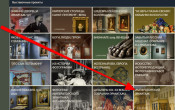
Internet and Museums: The virtual project “The Imperial Hermitage. Marking Its 170th Anniversary” launched
The new project The Imperial Hermitage. Marking Its 170th Anniversary was launched on the website of the State Hermitage Museum in the Virtual Visit section.
It features several sections highlighting different aspects of the life of the museum: the construction of the New Hermitage building, the creation of a public museum, the expansion of the collections, as well as the history of the museum’s first directors and keepers.
The virtual tour was based on the watercolour pictures, in which the artists Konstantin Ukhtomsky, Eduard Hau and Luigi Premazzi with astonishing precision captured looks of the halls and galleries of the New Hermitage. These pictures provide an opportunity to travel back to the Imperial Museum of the mid-1800s and stroll around its halls alongside the earliest visitors.
A series of photographs of the halls was taken specially for the virtual project to go with the watecolour pictures, in order to simultaneously show their similarities and differences. The photographing of the halls was done using a number of special techniques, including determining the viewpoint, panoramic and spherical shots, the processing and transformation of a panorama to produce a “flat” photograph, retouching and colour correction of the lighting.
The Imperial Hermitage was the first public museum in Russia, created by Tsar Nicholas I. He wanted to make the Russian rulers’ extremely rich art collections accessible to the general public.
Nicholas entrusted the design of a building for the future museum worthy of the works that were to be kept there to the celebrated Bavarian court architect Leo von Klenze. Vasily Stasov, whom the Emperor appointed chief architect of the Building Commission, was responsible for the implementation of Klenze’s concept, since Klenze himself was unable to carry out architectural supervision as he remained in the service of King Ludwig I of Bavaria.
The solemn opening of the museum, marked by a grand celebration held in the New Hermitage, took place on February 5, 1852. The event was complemented by a prayer service, large-scale receptions and balls.
By the beginning of XX Century, the Hermitage became a first-rate European-type museum with outstanding specialists working in it and hundreds of thousands people visiting it each year. World War I interrupted the normal life of the museum. When peace came after the revolutions and wars, the Hermitage had lost the word “Imperial” from its name.

